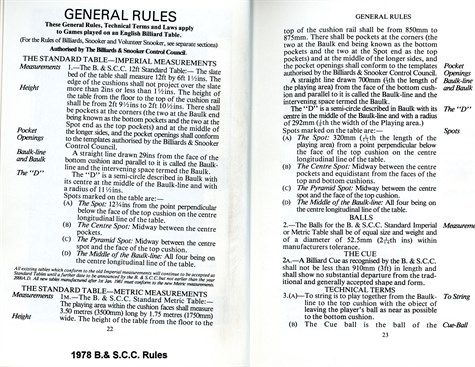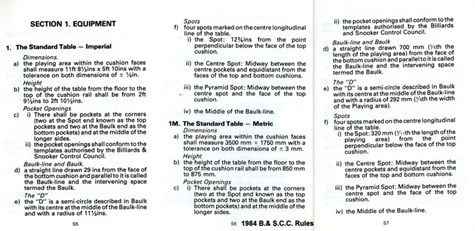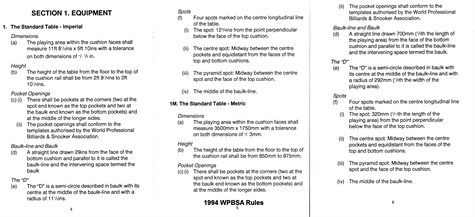Snooker/Billiard Table metrication
Billiards & Snooker Goes Metric by Norman Clare
Published in April 1970 edition of Billiards &
Snooker Magazine
(Note where Norman mentions Billiard tables this encompasses
Snooker Tables as well. Snooker was a game invented to be played on
a Billiard table. Additional information putting this 1970 article
into context and with rule book information is added at the end of
the article)
We already know our British Sterling Currency is to be based on
the decimal system from February 1971.
In the not very distant future we have also been warned that we
are to adopt the metric system of measurements. Thus we shall
purchase our potatoes by the kilogram instead of the pound and
measure our distances by kilometre instead of a mile.
To some extent the metric revolution in The United Kingdom has
already commenced.
This being so, the Billiard Association and Control Council(see
note 1), which is the World governing body for the games of U.K.
Billiards and Snooker, must soon give very careful consideration to
to restating those rules which specify measurements of "UK Billiard
Tables".
If, as a Nation, we are to derive the maximum advantage from
changing to the metric system, it is in my opinion, important that
we do not just convert our existing Imperial Measurements directly
into the metric system, as to do so will result in measurements
running into four decimal places. This would be extremely difficult
to remember and certainly difficult for a referee to check if they
decided to do so.
Ideally, we should if possible specify measurements based on the
multiples 5 and 10. It would be an easy matter to adopt new
measurements which varied slightly from the old if the article with
which we were concerned had a serviceable life of something like 10
years. Articles made to the old specification would soon be worn
out and replaced by those in the new metric sizes. However as this
is not the case with Billiard tables we are faced with a really
difficult problem; one which will not be made any easier when one
remembers how extremely conservative the average U.K. person really
is.
In the specification of a Billiard table, as published in the
B.A & C.C. Rules, there are in fact only two official sizes of
billiard table; the 12ft Standard table with a slate bed measuring
12ft long x 6ft 1 ½ inches wide and a B.A. & C.C. 6 ft. table
with a slate bed 6ft. Long x 3ft 1 ½ ins. wide.(see note 2)
Thus all the other many 'undersize' tables which exist are quite
'unofficial'. Furthermore, although the 6ft standard table has been
specified in the rules for many years , only an extremely small
percentage of existing 6ft tables conform to the official
measurements. In view of this I would suggest that Rule No.
1Aspecifying the size of a standard 6ft. Table is simply eliminated
from the rule book. This would not result in any problems at all,
as there are no official Championships played on the standard
6ft.Billiard table.
As far as the 12ft Standard (full size) Billiard table is
concerned, the size of the pocket openings require no alteration as
the rules simply specify that"the pocket openings shall conform to
the templates authorised by the B.A. & C.C."
The balls do not present any tremendous difficulty. The existing
rules state that the balls shall have a diameter of 2 1/16 inches ,
"within manufacturers tolerances" (what ever that means!) and that
they shall be of equal size and weight. A straight direct
conversion is probably the best answer. This would result in a ball
size being specified as being 52.3875mm (52.5mm)
We cannot very easily achieve the multiple of 5 or 10as this
would result in either a 50mm. which is fractionally less that 2
inches or 55mm which is almost 2 3/16 inches. Any other decision,
such as increasing the size of the ball in order that we might come
closer to the American size of 2 ¼ inches diameter, in order to
facilitate International Snooker competitions, would result in
almost every existing Billiard table requiring major modifications
to the cushions. Indeed, completely new cushions would be required
as the height of the cushion nose above the playing surface of the
table would need to be considerably increased.
The only other accessory which has a specified measurement is a
cue, which to conform with rule 2A must not be less than 3ft. Long
It really would not do any harm at all if this rule was altered so
that the minimum length of 1 meter was specified. The actual result
of so doing would be to increase the minimum length by
approximately 3 ½ inches but apart from one exciting occasion many
years ago before the minimum length of cue was specified in the
rules, when Alec Brown used a cue only a few inches long to play a
stoke. I think it is safe to say that nobody would be at all
worried if the minimum length was specified at 1 meter.
Let us now list those measurements which refer to the table
itself - followed by direct metric conversions in brackets:-
The bed of the table must measure 12ft long x 6ft 1 ½ ins wide
(365.76cms x 186.69cms)
The edge of the cushion shall project over the edge of the slate
bed not less that 1 ½ ins or more than 2 ins.(not less than 3.81cms
or more than 5.08cms)
The height of the Billiard Table from the floor to the top of
the cushion rail shall be not less than 2ft 9 ½
ins. nor more than 2ft 10 ½ ins. (not less than 85.09 cm, nor
more than 87.63cms)
The baulk line 29ins. From the face of the bottom cushion
(73.66cms)
The spot 12 ¾ ins. Below the face of the top cushion
(32.385cms.)
Clearly the above measurements, when converted directly into
metric measurements resulting figures which require "rounding off"
and so now at last we arrive at the point where real arguements
commence.
Before we get too deeply involved I think we should immediately
recognise that the job has to be tackled sensibly. Clearly the many
thousands of existing tables will have to be accepted as they now
stand so far as their "construction" is concerned but it should be
possible to rationalise the baulk line and spot positions gradually
over a relatively short period of time. During this period either
the old or the new rationalised measurements wood need to be
accepted without the table being "disqualified".
Before anybody should immediately take me to task for such a
suggestion, may I point out that there is already a tolerance in
the rules, which permits the cushion to project over the edge of
the table(slate)bed not less than 1 ½ ins and not more than 2
ins.
Taking note of this tolerance at both sides and both ends of the
tabble, we already have a situation where you can have a difference
in length of the playing surface of up to 1 inch (2.54cm)and also
in the width of the playing surface of up to 1 inch (2.54cm)
without either table contravening the rules. We have lived with
this tolerance for as many years as I can remember. Thus I submit
some tolerance in the baulk and spot positions might be accepted
whilst we fall in line with the nearest and most convenient metric
measurements. Indecently it would be interesting to try and find
out how the spot position ever came to be specified as 12 ¾ inches,
why not 13 inches or perhaps even the convenient measurement of one
foot?No doubt at some time in the past, there must have been many
heated arguments about this particular measurement and it seems to
be that there must have been some degree of compromise. Otherwise
how else could such and inconvenient measurement been selected?
Now I come to my most controversial suggestion. Whilst changes
in rules are being introduced to accomodate metric measurements, I
think the opportunity should be taken of specifying the actual
length and width of the playing area taking the measurements from
the face of the cushion instead of specifying the length and the
width of the table(slate)bed, followed by the permitted variations
in the projection of the cushion over the edge of the(slate)bed.
Such changes would give the Billiard table maker more latitude in
the design and construction, and method of fixing the cushion
rails. Dare I suggest that the length of the playing surface should
be 3.5 meters(3.5 meters equals approximately 11ft 6ins) by 1.75
meters wide (1.75mts equals approximately 5ft 9 ins) and bearing in
mind that the majority of existing Billiard tables have cushions
which project the maximum 2 inches over the edge of the slate bed,
the existing playing surface measuring within the face of the
cushions measures 11ft 8ins by 5ft 9 ½ inches.
Thus my suggested metric full size Billiard tables would have a
playing area in width just about ½ inch narrower than the existing
and 2 inches shorter. The great advantage would be that the width
would be exactly half the length so each half of the Billiard table
would be an exact square.
Both the old table made to the imperial measurements and the new
table made to the Metric measurements would have to be accepted as
standard full size tables for all purposes for a very long time
into the future.
I do not think that the relatively small differences between the
two sizes would be noticed by the vast majority of players and as
there is already an existing tolerance of 1 inch in both the length
and width, I think we could accept the necessary tolerances in
order that we can "go metric".
In my opinion we cannot just ignore the problem and hope it will
disappear. I am very well aware that the Billiard table, once
manufactured, last for 100 years or more and so it is thus very
easy to make excuses for not doing anything about the problem now.
But, any activity which does not move with the times to keep itself
up to date will ultimately die and so those of us today who have
some responsibility in these matters must not allow the situation
to go be default.
Notes & additional information :-
(1) The Billiard Association & Control Council changed its
title to the Billiard & Snooker Control Council sometime
between 1970 and 1974. Perhaps the name change was influnced by the
BBC 'Pot Black' programs which commenced in 1969 and brought the
game of Snooker to a wider global audience.
(2) The B.& S.C.C. rule books upto 1977 only had the
'Imperial Standard table' measurments. It should be noted that when
the original specifications table were drawn up the cushion nose
projection was 1 ½ inches which meant that the playing area
(between the cushion noses) was 11ft 6ins. by 5ft 10 ½ inches.
Which meant that each half of the playing area was an exact square.
Which is also true for American Pool tables and European Carom
Tables and what Norman achieved with his suggested Metric
conversion. However when the 2 inch cushion nose projection was
allowed this destroyed that geometric shape on Uk Billiard tables.
Norman was therefore trying to correct this anomaly with his metric
suggestion. Just in passing the 2 inch cushion nose projection was
probably adopted as it "improved" the appearance of the cushion by
giving the impression of more cushion rubber being used!!
(3) The 1978 B.& S.C.C. Rule book has both Imperial &
metric StandardTables. Susquently even the Imperial measurements
were based on the playing area rather than the slate size. This was
stated as 11ft 8 ½ inches long by 10ft 5 inches wide with a
tolerance of +/- ½ inch.

Playing Area specified in Imperial measurements in the 1984
B.& S.C.C.rules


So from the above entries it seems that some time between
1978 and 1984 the B.& S.C.C. Revised the imperial specification
so that the playing area was stipulated rathe than the slate bed
and cushion nose projection. The last rule book that we have in the
collection that list the "Standard Metric" table is a WPBSA 1993
one.
The major table makers in the mid 1970 did start to make
their full size tables to the metric specification but as the
1980's were the time when numerous Snooker halls were opened new
table makers were not aware of the "Rules" and just copied existing
'old' tables. Thus the metric tables were swamped by the numerous
other makers and basically are no longer made. However quite a
number ofmetric tablesare in play and as Norman mentioned in his
article that tables will be arround for a long number of years so
must still be considered as "Standerd Full Size Tables"!!
© Norman Clare 1990. © E.A.
Clare & Son Ltd. 2018. © Peter N. Clare 2018
Reproduction of this article allowed only with the permission from
E.A. Clare & Son Ltd.

